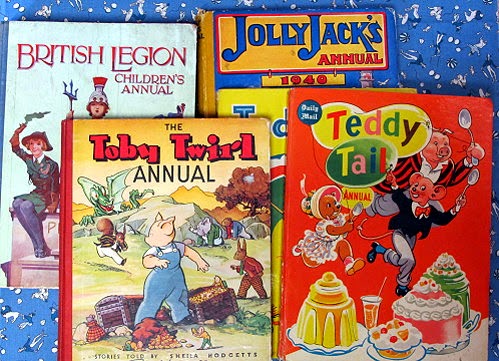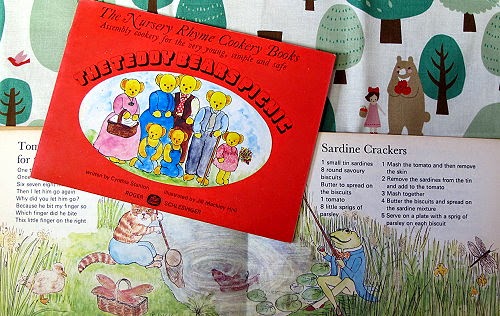Having enjoyed our summer break it’s now time to start replenishing the shelves. This is a quick preview of some newly listed items.
Ginger the cat - the strange tale of a tail. A Tuck Book published by Raphael Tuck in 1945. If ever there was a bold, bad cat, it was Ginger! Beautifully illustrated in full colour by Harry Woolley.
Ginger the cat is now sold, thank you for your interest.What to look for in autumn illustrated by the wildlife artist C. F. Tunnicliffe (1901 – 1979) published by Ladybird books in 1960. C.F. Tunnicliffe was commissioned to illustrate five books for Ladybird: What to look for in spring, What to look for in summer, What to look for in autumn, What to look for in winter (first published 1959-1961) and a ‘Learning to read’ book The Farm.
A selection of fun annuals; 
The Teddy Tail annual featured here is now sold but we do have others in stock.
The Teddy bears picnic and the frog and Miss Mouse's wedding. Cookery for the very young, simple and safe.Colour illustrations throughout both books by Jill Mackley Hall. Recipes with ingredients that are simply assembled and need little supervision. All kinds of delights for the youngest child to try including crispy nutty delights, sardine crackers, Queens tarts, orange iceberg drink, banana spread, chocolate ice cream cups and corned beef whirls. Covers just a little rubbed on edges and some darkening to edges of pages else very good. Published in 1973. Priced at just £6.00 for the two.
A nice collection of the ever popular Pookie books by Ivy Wallace. Further details here
Ivy Wallace became a publishing phenomenon in the 1950s and 1960s with a series of children's books chronicling the adventures of Pookie, the flying rabbit who leaves his home in the Bluebell Wood to seek his fortune with a red spotted bundle tied on a stick; in the 1990s, she became one of the few writers to be rediscovered in her own lifetime.
A keen amateur artist, Ivy Wallace created Pookie during the Second World War. The books, beautifully illustrated by their author with every flower drawn from nature, became a worldwide success with the stories being translated into several languages and Pookie clubs as far afield as Australia, Canada and South Africa.
(The Telegraph online) Read moreCuckoo Cherry-Tree by Alison Uttley. A book of twelve original fairy tales for all ages, imbued with country lore and magic, with a background of woods and fields and cottages where simple folk live. Published by Faber & Faber in 1944. How nice it is to have the original dust jacket with this pretty book.
All the books featured here are available (unless previously sold) to view or purchase at
March House Books. Please use the quick search boxes on the home page or follow the links. Thanks to everyone who called in to wish me a happy holiday. I will be catching up with all your blogs just as soon as I can.
I was lucky enough to visit the magical Hay-on-Wye ‘book town’ and the wonderful Alfies Antiques Market in Marylebone and will be sharing some of the 'photos in a later post.
A few of the books acquired on my recent travels, some of which are available in my shop, others will be listed in the next few days.
And just to prove I did more than lounge around on my holiday...
Well, a girl can dream!
I will be listing other interesting things over the next few days so if you have a few minutes to spare why not pay a visit to
March HouseBooks where you will find...
My books are full of pictures of interesting places -
of circus tents and lions and clowns with funny faces!
By Nicola Humble
BBC 2 has rediscovered Mrs Beeton, with Sophie Dahl tramping the streets of Cheapside and Epsom looking for the real woman behind Household Management. It is worth the shoe leather – Mrs Beeton’s is certainly a story well worth telling. The author of the most famous cook book ever published began work on it at the age of twenty-one and finished it at four years later. Her book was first published in volume form in 1861 and has never been out of print since. Isabella herself died seven years after its publication of puerperal fever, contracted during the birth of her fourth child. She was 28.
The crisp, authoritative tones of her book, along with its immense size and heft, and the range and assurance of its advice have all encouraged generations of readers to imagine Mrs Beeton as a stately matron, doling out the fruits of long years of domestic experience. It is a model of the author deliberately encouraged by Ward Lock, the book’s long-term publishers, who tacitly avoided all mention of the author’s untimely death. In fact the real Isabella Beeton was the polar opposite of what we would expect. She had spent much of her adolescence living with her siblings in the grandstand on Epsom race course, where her step-father was Clerk of the Course. They slept in the committee rooms and ran wild, while Isabella, the eldest, presided over the ramshackle domestic arrangements. She followed this highly unconventional upbringing by taking herself off to learn pastry-making in Germany – conduct, according to one of her sisters, that was considered ‘ultra-modern and not quite nice’. On her return she became engaged to a young entrepreneurial publisher, Sam Beeton. For the rest of their brief married life she was to work alongside him, contributing to his publications. She wrote columns on fashion and travelled to Paris with great enjoyment to report on the fashion shows, she translated French novels for serialisation, and wrote on food and household management for the Englishwoman’s Domestic Magazine. It was these that formed the basis of the book.
Mrs Beeton gets rediscovered every generation: there was a huge stir in the 1930s when her son, Sir Mayson Beeton, presented a picture of his mother to the National Portrait Gallery and people tried to reconcile the fashionable young girl of the picture with the mature woman of their imaginings. In the 1970s, when traditional English food enjoyed a renaissance, there was again a new surge of interest in Beeton and her book. And in the last decade there have been flurries of media enthusiasm in reponse to Kathryn Hughes’s 2005 biography (The Short Life and Long Times of Mrs Beeton) and to my own edition of her work for Oxford World’s Classics. When the latter appeared in 2000 I was astonished by the degree of interest the book received on national and local radio, in broadsheets and tabloids alike. It was even the subject of a Mark Rowson cartoon in The Independent. The curiosity was two-fold: it was news-worthy because a highly respected literary series was allowing a cook book to join the hallowed ranks of serious literature, but there was also a lot of interest in the book and its author: in the oddities of Isabella’s story and in the anomolous cultural status the book possesses, as something both immensely famous and largely unread.
So why is it worth us reading Beeton’s book today? For one thing, it is a record of a society caught at a crucial moment of transi











